NAD+ Metabolism-Related Gene Profile Can Be a Relevant Source of Squamous Cell Carcinoma Biomarkers
Abstract
Simple Summary
Abstract
1. Introduction
2. Materials and Methods
2.1. Data Source
- Receiver Operating Characteristic (ROC) curve analysis
2.2. Principal Component Analysis (PCA)
2.3. Immune Microenvironment Analysis
2.4. Correlation with PD-1 and PD-L1
2.5. Survival Analysis
2.6. Statistical Analysis
3. Results
3.1. NMRGs and Their Ability as SCC-Type Discriminating Biomarkers
3.2. NMRGs and Their Ability as SCC Discriminating Biomarkers
3.3. NMRG Expression and Risk Factors
3.4. NMRGs as Diagnostic Biomarkers for Patient Stratification
3.5. NMRGs and Immune Microenvironment Characterization
3.6. NMRGs and Immune Checkpoints
3.7. NMRGs as Prognostic Biomarkers
4. Discussion
- (i)
- several differentially expressed NMRGs display good diagnostic power in discriminating tumors from control specimens. Specifically, we found 6 genes for HNSCC (AOX1, NMNAT2, ENPP3, NADK, CD38, and PARP1), 11 genes for LuSCC (AOX1, NNMT, NMNAT2, NMNAT3, ENPP2, ENPP3, NMRK2, NADSYN1, SIRT1, CD38, and PARP1) and 11 genes for CeSCC (AOX1, NMNAT3, ENPP1, ENPP2, ENPP3, NMRK2, PNP, NADSYN1, SIRT1, SIRT3, and CD38);
- (ii)
- three differentially-expressed NMRGs can be considered relevant SCC-type specific biomarkers;
- (iii)
- specific NMRG signatures display high diagnostic power for several clinical-pathological characteristics.
5. Conclusions
Supplementary Materials
Author Contributions
Funding
Institutional Review Board Statement
Informed Consent Statement
Data Availability Statement
Conflicts of Interest
List of Abbreviations
| SCC | Squamous cell carcinoma |
| HNSCC | Head and Neck Squamous cell carcinoma |
| LuSCC | Head and Neck Squamous cell carcinoma |
| CeSCC | cervix Squamous cell carcinoma |
| HPV | human papillomavirus |
| NSCLC | non-small cell lung cancer |
| NAD+ | Nicotinamide adenine dinucleotide |
| NAM | nicotinamide |
| NMN | nicotinamide mononucleotide |
| NR | nicotinamide riboside |
| NMRG | NAD+ metabolism-related gene |
| TCGA | The Cancer Genome Atlas |
| GTEx | Genotype-Tissue Expression |
| ROC | Receiver Operating Characteristic |
| AUC | Area under the curve |
| PCA | Principal component analysis |
| KIRC | Kidney Renal clear cell Carcinoma |
| GBM | Glioblastoma |
| SARC | Sarcoma |
| TIMER | Tumor IMmune Estimation Resource |
| OS | overall survival |
| SAM | S-adenosyl-L-methionine |
| ATP | adenosine triphosphate |
| NAMPT | NAM phosphoribosyltransferase |
| NAMN | NAM mononucleotide |
| NMNATs | NMN adenyltransferases |
| NADK | NAD kinase |
| cADPRS | cyclic ADP-ribose synthase |
| PARPs | Poly-ADP-ribose-polymerases |
| SIRT | Sirtuins |
| Sub | substrates |
| MNA | 1-methyl-NAM |
| NNMT | NAM-N-methyltransferase |
| 2-Pyr | l-methyl-2-pyridone-5-carboxamide |
| 4-Pyr | l-methyl-4-pyridone- 5-carboxamide |
References
- Yan, W.; Wistuba, I.I.; Emmert-buck, M.R.; Erickson, H.S. SCC Highlights and Insights. Am. J. Cancer Res. 2011, 1, 275–300. [Google Scholar]
- Mäkitie, A.A.; Agaimy, A.; Almangush, A. Insight into Classification and Risk Stratification of Head and Neck Squamous Cell Carcinoma in Era of Emerging Biomarkers with Focus on Histopathologic Parameters. Cancers 2022, 14, 5514. [Google Scholar] [CrossRef]
- Guan, Y.; Wang, G.; Fails, D.; Nagarajan, P.; Ge, Y. Unraveling Cancer Lineage Drivers in Squamous Cell Carcinomas. Pharmacol. Ther. 2020, 206, 107448. [Google Scholar] [CrossRef]
- Campos-Parra, A.D.; Pérez-Quintanilla, M.; Martínez-Gutierrez, A.D.; Pérez-Montiel, D.; Coronel-Martínez, J.; Millan-Catalan, O.; De León, D.C.; Pérez-Plasencia, C. Molecular Differences between Squamous Cell Carcinoma and Adenocarcinoma Cervical Cancer Subtypes: Potential Prognostic Biomarkers. Curr. Oncol. 2022, 29, 4689–4702. [Google Scholar] [CrossRef]
- Solomon, B.; Young, R.J.; Rischin, D. Head and Neck Squamous Cell Carcinoma: Genomics and Emerging Biomarkers for Immunomodulatory Cancer Treatments. Semin. Cancer Biol. 2018, 52, 228–240. [Google Scholar] [CrossRef]
- Patel, R.; Chang, A.L.S. Immune Checkpoint Inhibitors for Treating Advanced Cutaneous Squamous Cell Carcinoma. Am. J. Clin. Dermatol. 2019, 20, 477–482. [Google Scholar] [CrossRef]
- Dotto, G.P. Multifocal Epithelial Tumors and Field Cancerization: Stroma as a Primary Determinant. J. Clin. Investig. 2014, 124, 1446–1453. [Google Scholar] [CrossRef]
- Dotto, G.P.; Rustgi, A.K. Squamous Cell Cancers: A Unified Perspective on Biology and Genetics. Cancer Cell 2016, 29, 622–637. [Google Scholar] [CrossRef]
- Hanahan, D.; Weinberg, R.A. Hallmarks of Cancer: The next Generation. Cell 2011, 144, 646–674. [Google Scholar] [CrossRef]
- Fania, L.; Mazzanti, C.; Campione, E.; Candi, E.; Abeni, D.; Dellambra, E. Role of Nicotinamide in Genomic Stability and Skin Cancer Chemoprevention. Int. J. Mol. Sci. 2019, 20, 5946. [Google Scholar] [CrossRef]
- Xie, N.; Zhang, L.; Gao, W.; Huang, C.; Huber, P.E.; Zhou, X.; Li, C.; Shen, G.; Zou, B. NAD+ Metabolism: Pathophysiologic Mechanisms and Therapeutic Potential. Signal Transduct. Target. Ther. 2020, 5, 227. [Google Scholar] [CrossRef] [PubMed]
- Nikas, I.P.; Paschou, S.A.; Ryu, H.S. The Role of Nicotinamide in Cancer Chemoprevention and Therapy. Biomolecules 2020, 10, 477. [Google Scholar] [CrossRef] [PubMed]
- Chen, A.C.; Martin, A.J.; Choy, B.; Fernández-Peñas, P.; Dalziell, R.A.; McKenzie, C.A.; Scolyer, R.A.; Dhillon, H.M.; Vardy, J.L.; Kricker, A.; et al. A Phase 3 Randomized Trial of Nicotinamide for Skin-Cancer Chemoprevention. N. Engl. J. Med. 2015, 373, 1618–1626. [Google Scholar] [CrossRef] [PubMed]
- Drago, F.; Ciccarese, G.; Cogorno, L.; Calvi, C.; Marsano, L.A.; Parodi, A. Prevention of Non-Melanoma Skin Cancers with Nicotinamide in Transplant Recipients: A Case-Control Study. Eur. J. Dermatol. 2017, 27, 382–385. [Google Scholar] [CrossRef]
- Janssens, G.O.; Rademakers, S.E.; Terhaard, C.H.; Doornaert, P.A.; Bijl, H.P.; van den Ende, P.; Chin, A.; Marres, H.A.; de Bree, R.; van der Kogel, A.J.; et al. Accelerated Radiotherapy with Carbogen and Nicotinamide for Laryngeal Cancer: Results of a Phase III Randomized Trial. J. Clin. Oncol. 2012, 30, 1777–1783. [Google Scholar] [CrossRef] [PubMed]
- Janssens, G.O.; Terhaard, C.H.; Doornaert, P.A.; Bijl, H.P.; van den Ende, P.; Chin, A.; Pop, L.A.; Kaanders, J.H. Acute Toxicity Profile and Compliance to Accelerated Radiotherapy plus Carbogen and Nicotinamide for Clinical Stage T2-4 Laryngeal Cancer: Results of a Phase III Randomized Trial. Int. J. Radiat. Oncol. Biol. Phys. 2012, 82, 532–538. [Google Scholar] [CrossRef]
- Li, T.; Fan, J.; Wang, B.; Traugh, N.; Chen, Q.; Liu, J.S.; Li, B.; Liu, X.S. TIMER: A Web Server for Comprehensive Analysis of Tumor-Infiltrating Immune Cells. Cancer Res. 2017, 77, e108–e110. [Google Scholar] [CrossRef] [PubMed]
- Li, B.; Severson, E.; Pignon, J.-C.; Zhao, H.; Li, T.; Novak, J.; Jiang, P.; Shen, H.; Aster, J.C.; Rodig, S.; et al. Comprehensive Analyses of Tumor Immunity: Implications for Cancer Immunotherapy. Genome Biol. 2016, 17, 174. [Google Scholar] [CrossRef]
- Li, T.; Fu, J.; Zeng, Z.; Cohen, D.; Li, J.; Chen, Q.; Li, B.; Liu, X.S. TIMER2.0 for Analysis of Tumor-Infiltrating Immune Cells. Nucleic Acids Res. 2020, 48, W509–W514. [Google Scholar] [CrossRef]
- Zhou, C.; Diao, P.; Wu, Y.; Wei, Z.; Jiang, L.; Zhang, W.; Li, Z.; Ye, J.; Song, X.; Wu, H.; et al. Development and Validation of a Seven-Immune-Feature-Based Prognostic Score for Oral Squamous Cell Carcinoma after Curative Resection. Int. J. Cancer 2020, 146, 1152–1163. [Google Scholar] [CrossRef]
- Chini, C.; Hogan, K.A.; Warner, G.M.; Tarragó, M.G.; Peclat, T.R.; Tchkonia, T.; Kirkland, J.L.; Chini, E. The NADase CD38 Is Induced by Factors Secreted from Senescent Cells Providing a Potential Link between Senescence and Age-Related Cellular NAD+ Decline. Biochem. Biophys. Res. Commun. 2019, 513, 486–493. [Google Scholar] [CrossRef] [PubMed]
- Covarrubias, A.J.; Kale, A.; Perrone, R.; Lopez-Dominguez, J.A.; Pisco, A.O.; Kasler, H.G.; Schmidt, M.S.; Heckenbach, I.; Kwok, R.; Wiley, C.D.; et al. Senescent Cells Promote Tissue NAD+ Decline during Ageing via the Activation of CD38+ Macrophages. Nat. Metab. 2020, 2, 1265–1283. [Google Scholar] [CrossRef] [PubMed]
- Johnson, D.E.; Burtness, B.; Leemans, C.R.; Lui, V.W.Y.; Bauman, J.E.; Grandis, J.R. Head and Neck Squamous Cell Carcinoma. Nat. Rev. Dis. Prim. 2020, 6, 92. [Google Scholar] [CrossRef] [PubMed]
- Lei, Q.; Wang, D.; Sun, K.; Wang, L.; Zhang, Y. Resistance Mechanisms of Anti-PD1/PDL1 Therapy in Solid Tumors. Front. Cell Dev. Biol. 2020, 8, 672. [Google Scholar] [CrossRef] [PubMed]
- Lim, Y.Z.; South, A.P. Tumour-Stroma Crosstalk in the Development of Squamous Cell Carcinoma. Int. J. Biochem. Cell Biol. 2014, 53, 450–458. [Google Scholar] [CrossRef] [PubMed]
- Fang, J.; Chen, W.; Hou, P.; Liu, Z.; Zuo, M.; Liu, S.; Feng, C.; Han, Y.; Li, P.; Shi, Y.; et al. NAD+ Metabolism-Based Immunoregulation and Therapeutic Potential. Cell Biosci. 2023, 13, 81. [Google Scholar] [CrossRef]
- Wu, M.; Huang, Q.; Xie, Y.; Wu, X.; Ma, H.; Zhang, Y.; Xia, Y. Improvement of the Anticancer Efficacy of PD-1/PD-L1 Blockade via Combination Therapy and PD-L1 Regulation; BioMed Central: London, UK, 2022; Volume 15, ISBN 1304502201. [Google Scholar]
- Lv, H.; Lv, G.; Chen, C.; Zong, Q.; Jiang, G.; Ye, D.; Cui, X.; He, Y.; Xiang, W.; Han, Q.; et al. NAD+ Metabolism Maintains Inducible PD-L1 Expression to Drive Tumor Immune Evasion. Cell Metab. 2021, 33, 110–127.e5. [Google Scholar] [CrossRef]
- Damian, D.L. Nicotinamide for Skin Cancer Chemoprevention. Australas. J. Dermatol. 2017, 58, 174–180. [Google Scholar] [CrossRef]
- Zhang, W.; Chai, W.; Zhu, Z.; Li, X. Aldehyde Oxidase 1 Promoted the Occurrence and Development of Colorectal Cancer by Up-Regulation of Expression of CD133. Int. Immunopharmacol. 2020, 85, 106618. [Google Scholar] [CrossRef]
- Xiong, L.; Feng, Y.; Hu, W.; Tan, J.; Li, S.; Wang, H. Expression of AOX1 Predicts Prognosis of Clear Cell Renal Cell Carcinoma. Front. Genet. 2021, 12, 683173. [Google Scholar] [CrossRef]
- Vantaku, V.; Putluri, V.; Bader, D.A.; Maity, S.; Ma, J.; Arnold, J.M.; Rajapakshe, K.; Donepudi, S.R.; von Rundstedt, F.-C.; Devarakonda, V.; et al. Epigenetic Loss of AOX1 Expression via EZH2 Leads to Metabolic Deregulations and Promotes Bladder Cancer Progression. Oncogene 2020, 39, 6265–6285. [Google Scholar] [CrossRef]
- Wang, W.; Yang, C.; Wang, T.; Deng, H. Complex Roles of Nicotinamide N-Methyltransferase in Cancer Progression. Cell Death Dis. 2022, 13, 267. [Google Scholar] [CrossRef]
- Moutafi, M.; Economopoulou, P.; Rimm, D.; Psyrri, A. PARP Inhibitors in Head and Neck Cancer: Molecular Mechanisms, Preclinical and Clinical Data. Oral Oncol. 2021, 117, 105292. [Google Scholar] [CrossRef] [PubMed]
- Doñate, F.; Raitano, A.; Morrison, K.; An, Z.; Capo, L.; Aviña, H.; Karki, S.; Morrison, K.; Yang, P.; Ou, J.; et al. AGS16F Is a Novel Antibody Drug Conjugate Directed against ENPP3 for the Treatment of Renal Cell Carcinoma. Clin. Cancer Res. 2016, 22, 1989–1999. [Google Scholar] [CrossRef] [PubMed]
- Ullah, S.; El-Gamal, M.I.; Zaib, S.; Anbar, H.S.; Zaraei, S.O.; Sbenati, R.M.; Pelletier, J.; Sévigny, J.; Oh, C.H.; Iqbal, J. Synthesis, Biological Evaluation, and Docking Studies of New Pyrazole-Based Thiourea and Sulfonamide Derivatives as Inhibitors of Nucleotide Pyrophosphatase/Phosphodiesterase. Bioorg. Chem. 2020, 99, 103783. [Google Scholar] [CrossRef]
- Chen, Y.; Yang, L.; Lu, Y.; Liu, N.; Ma, W.; Fan, H.; Hu, Q.; Han, X.; Gan, W.; Li, D. Up-Regulation of NMRK2 Mediated by TFE3 Fusions Is the Key for Energy Metabolism Adaption of Xp11.2 Translocation Renal Cell Carcinoma. Cancer Lett. 2022, 538, 215689. [Google Scholar] [CrossRef]
- Tedeschi, P.M.; Bansal, N.; Kerrigan, J.E.; Abali, E.E.; Scotto, K.W.; Bertino, J.R. NAD+ Kinase as a Therapeutic Target in Cancer. Clin. Cancer Res. 2016, 22, 5189–5195. [Google Scholar] [CrossRef]
- Schild, T.; McReynolds, M.R.; Shea, C.; Low, V.; Schaffer, B.E.; Asara, J.M.; Piskounova, E.; Dephoure, N.; Rabinowitz, J.D.; Gomes, A.P.; et al. NADK Is Activated by Oncogenic Signaling to Sustain Pancreatic Ductal Adenocarcinoma. Cell Rep. 2021, 35, 109238. [Google Scholar] [CrossRef]
- Oka, S.I.; Titus, A.S.; Zablocki, D.; Sadoshima, J. Molecular Properties and Regulation of NAD+ Kinase (NADK). Redox Biol. 2023, 59, 102561. [Google Scholar] [CrossRef]
- Pissios, P. Nicotinamide N-Methyltransferase: More than a Vitamin B3 Clearance Enzyme. Trends Endocrinol. Metab. 2017, 28, 340–353. [Google Scholar] [CrossRef]
- Zhu, X.-J.; Lin, Y.-J.; Chen, W.; Wang, Y.-H.; Qiu, L.-Q.; Cai, C.-X.; Xiong, Q.; Chen, F.; Chen, L.-H.; Zhou, Q.; et al. Physiological Study on Association between Nicotinamide N-Methyltransferase Gene Polymorphisms and Hyperlipidemia. Biomed Res. Int. 2016, 2016, 7521942. [Google Scholar] [CrossRef] [PubMed]
- Campagna, R.; Pozzi, V.; Sartini, D.; Salvolini, E.; Brisigotti, V.; Molinelli, E.; Campanati, A.; Offidani, A.; Emanuelli, M. Beyond Nicotinamide Metabolism: Potential Role of Nicotinamide N-methyltransferase as a Biomarker in Skin Cancers. Cancers 2021, 13, 4943. [Google Scholar] [CrossRef] [PubMed]
- Ruiz-Fernández de Córdoba, B.; Martínez-Monge, R.; Lecanda, F. ENPP1 Immunobiology as a Therapeutic Target. Clin. Cancer Res. 2023, 29, 2184–2193. [Google Scholar] [CrossRef]
- Liu, W.; Zhu, M.; Li, X.; Er, L.; Li, S. NNMT Is an Immune-Related Prognostic Biomarker That Modulates the Tumor Microenvironment in Pan-Cancer. Dis. Markers 2023, 2023, 9226712. [Google Scholar] [CrossRef] [PubMed]
- Lin, T. Updated Functional Roles of NAMPT in Carcinogenesis and Therapeutic Niches. Cancers 2022, 14, 2059. [Google Scholar] [CrossRef]
- Navas, L.E.; Carnero, A. NAD+ Metabolism, Stemness, the Immune Response, and Cancer. Signal Transduct. Target. Ther. 2021, 6, 2. [Google Scholar] [CrossRef]
- Nagy, Á.; Lánczky, A.; Menyhárt, O.; Győrffy, B. Validation of MiRNA Prognostic Power in Hepatocellular Carcinoma Using Expression Data of Independent Datasets. Sci. Rep. 2018, 8, 9227. [Google Scholar] [CrossRef]
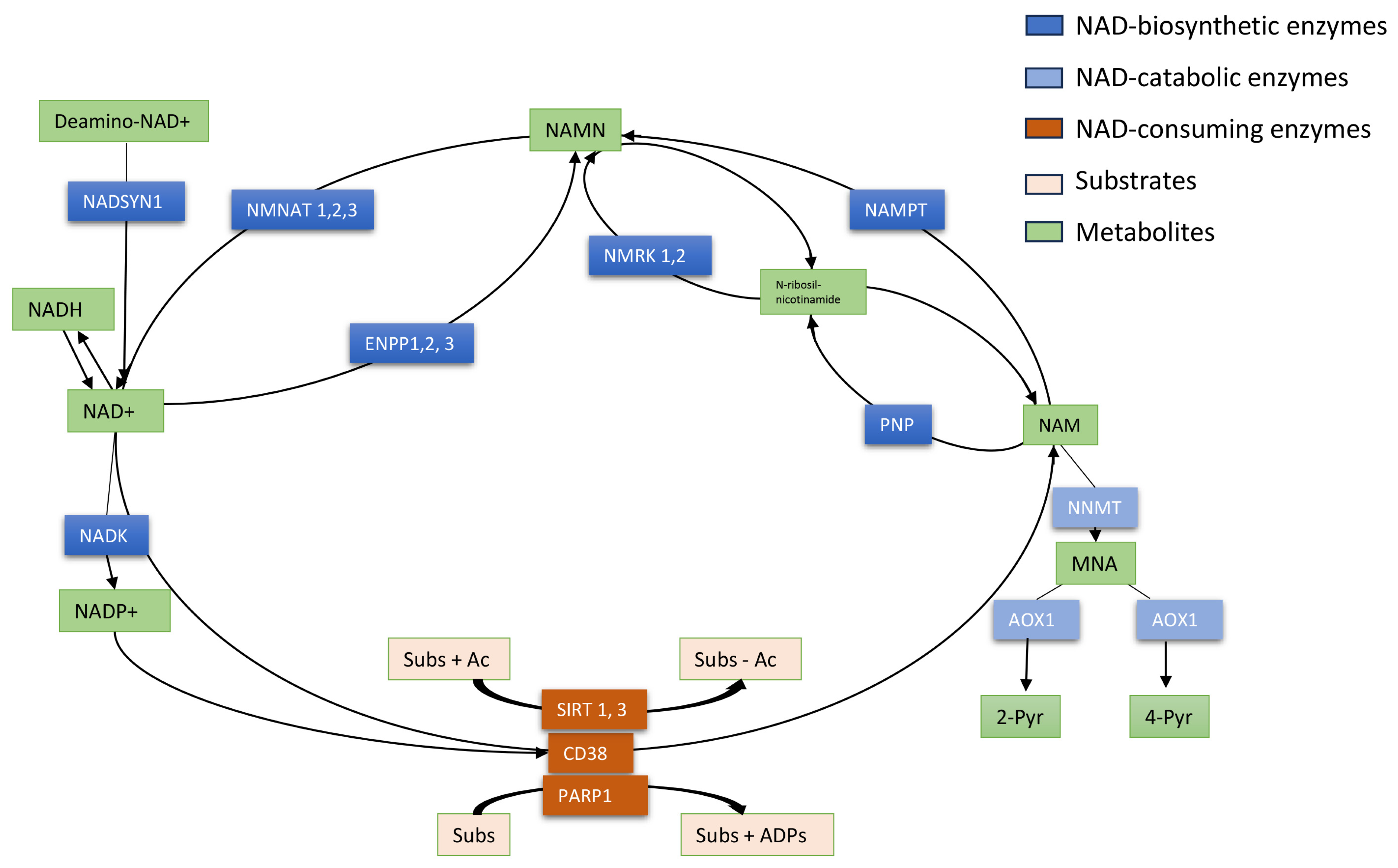
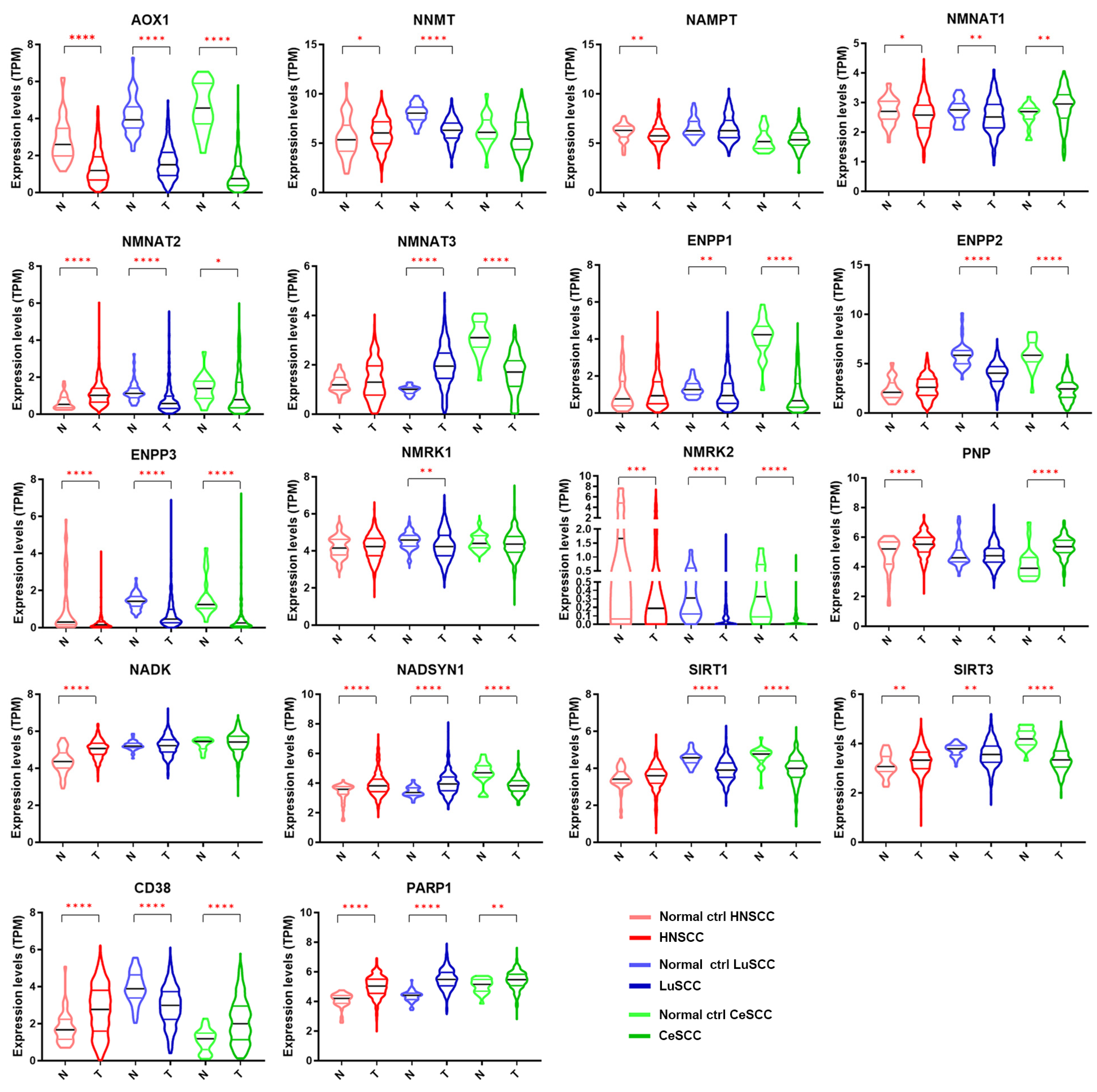
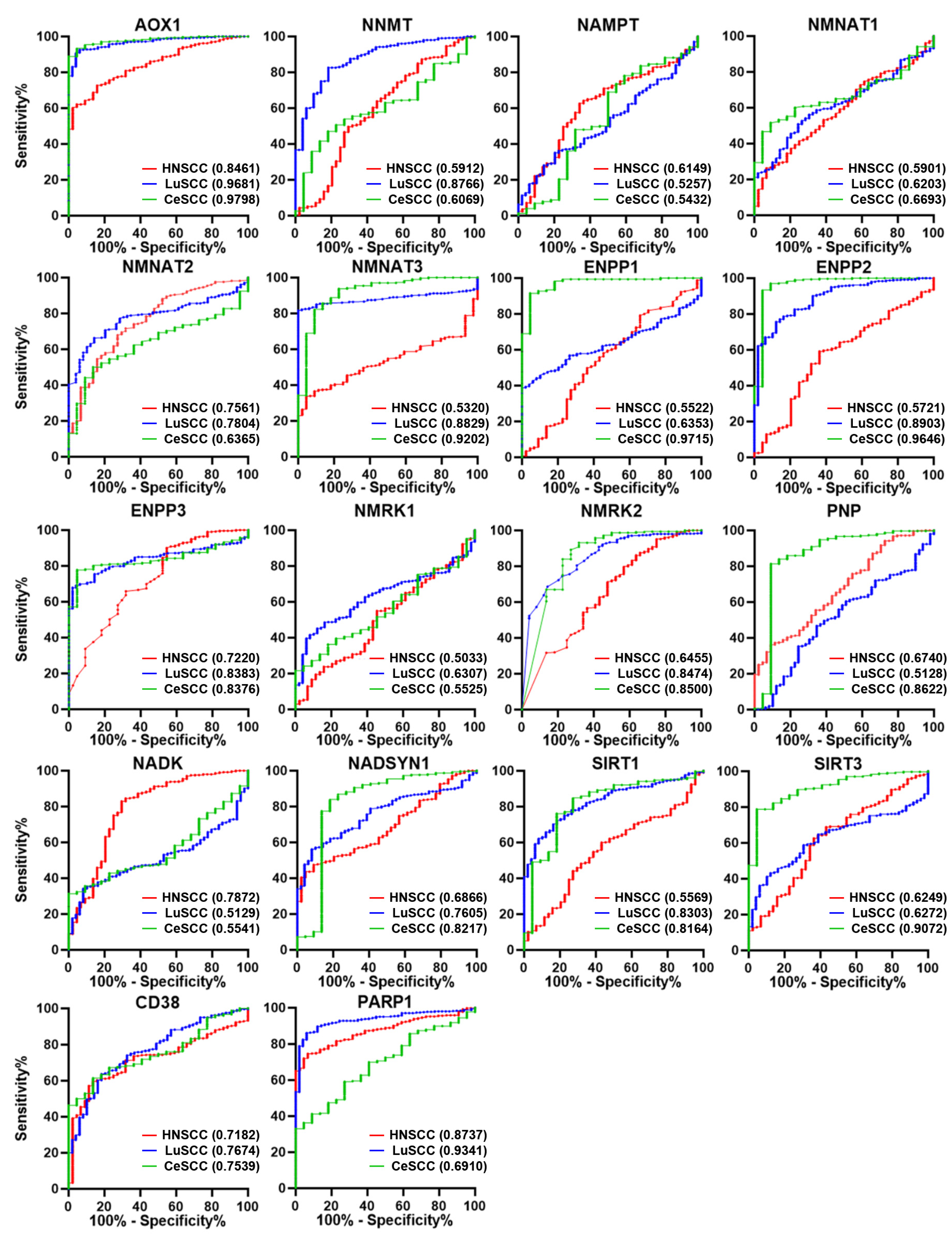
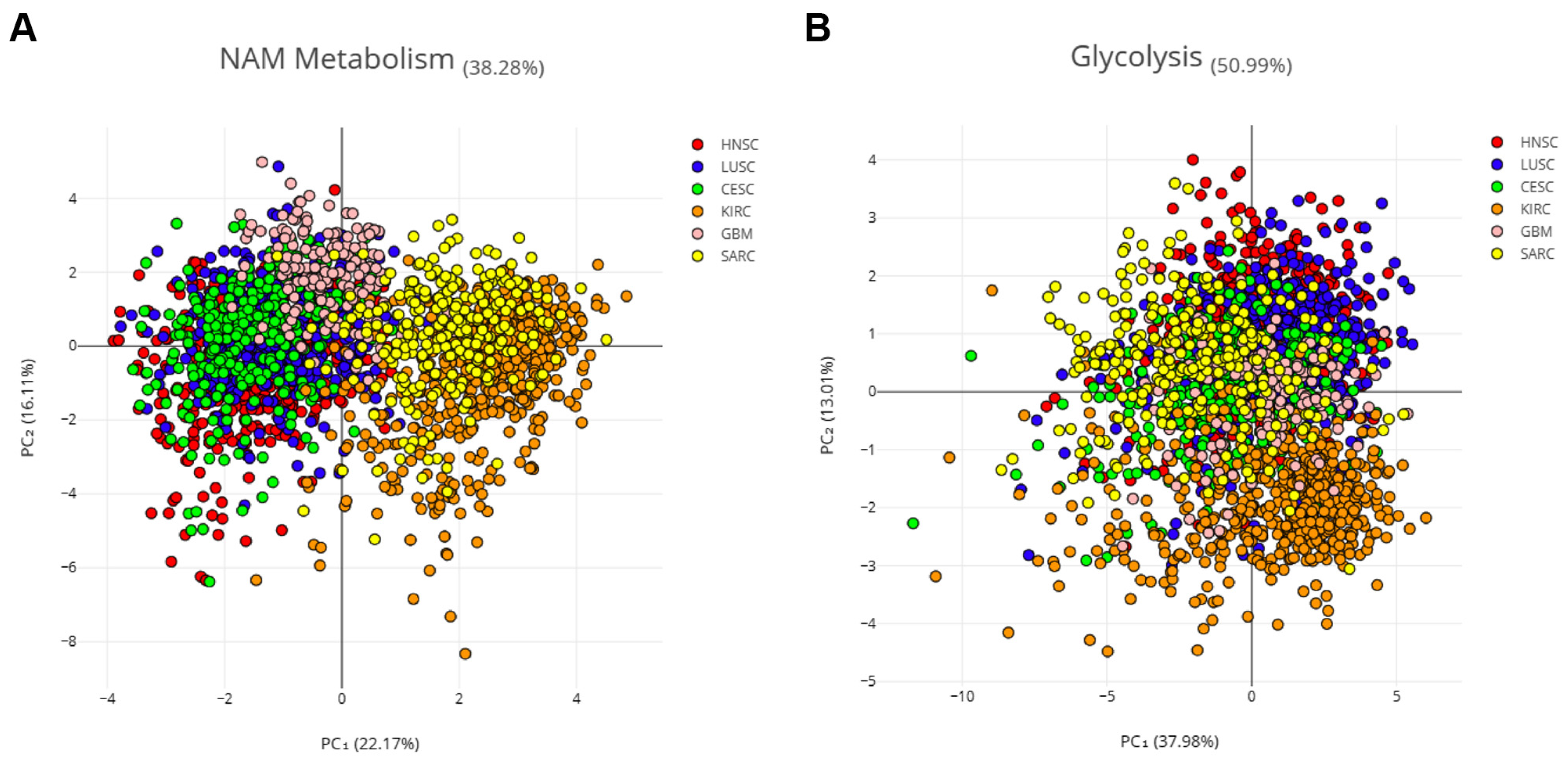

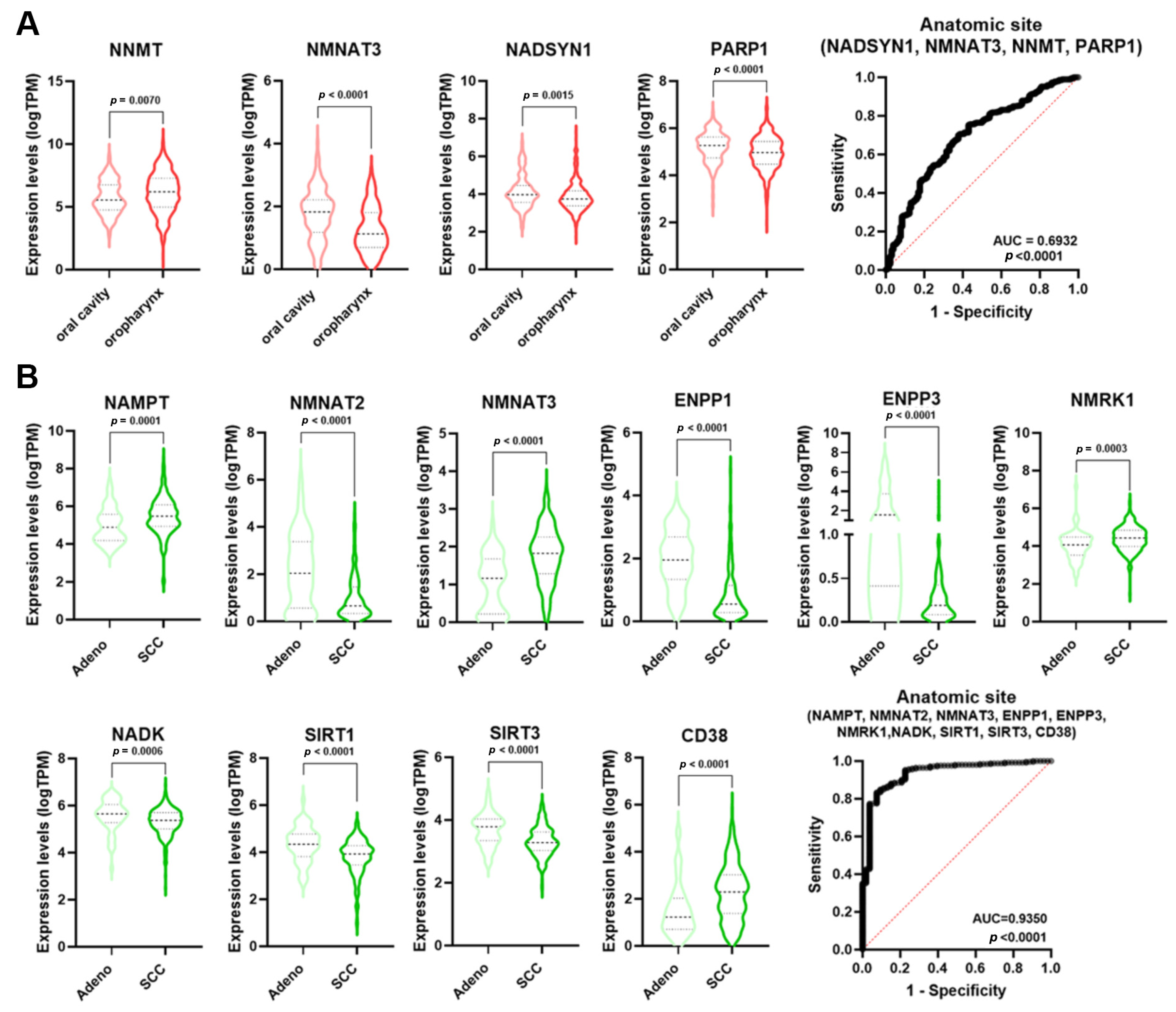
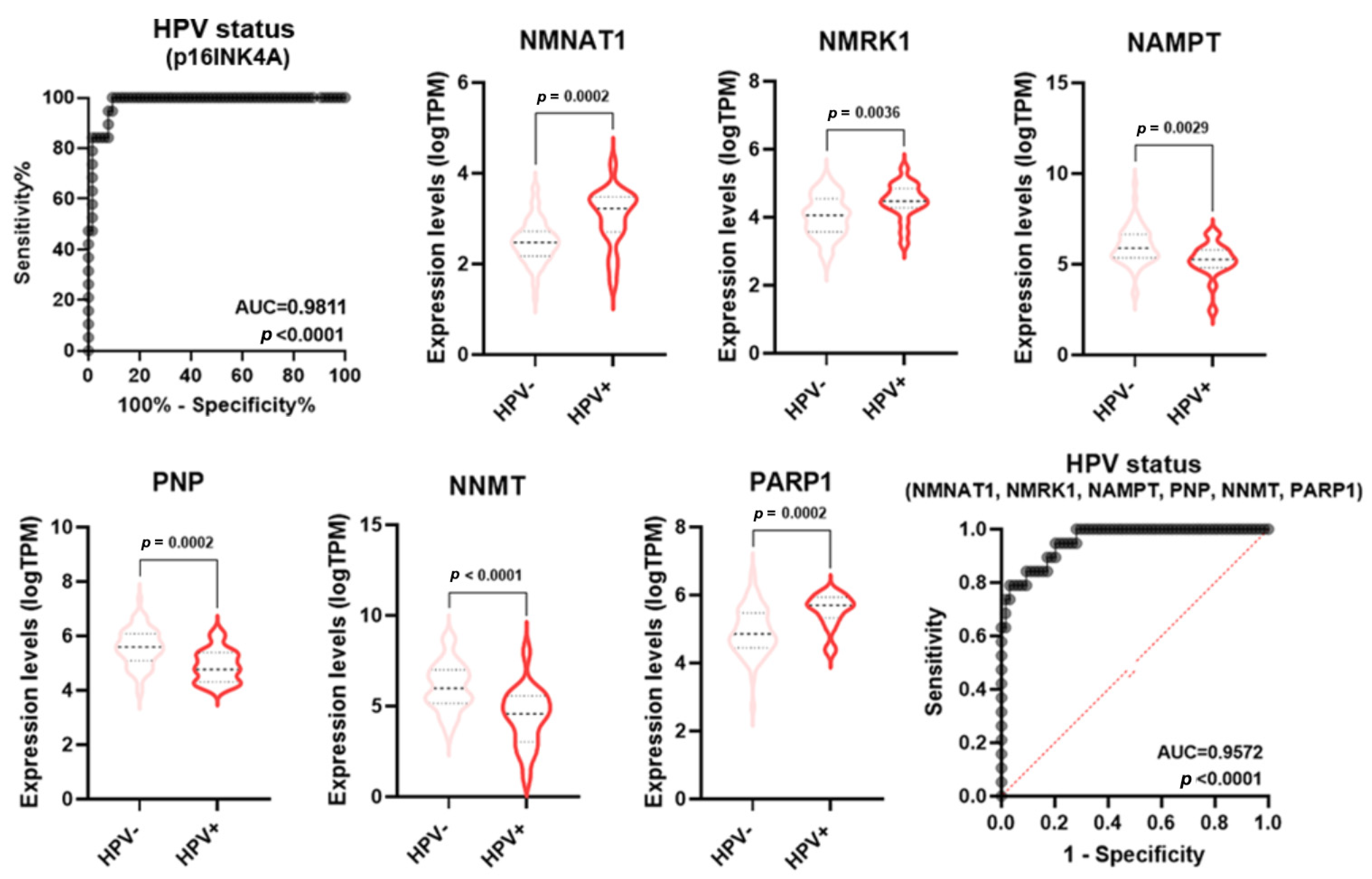

| HNSCC | LuSCC | CeSCC | ||||||||||||||||||||||
|---|---|---|---|---|---|---|---|---|---|---|---|---|---|---|---|---|---|---|---|---|---|---|---|---|
| Genes | B Cell | CD8+ T Cell | CD4+ T Cell | Macrophage | Neutrophil | Dendritic Cell | PD-1 | PD-L1 | B Cell | CD8+ T Cell | CD4+ T Cell | Macrophage | Neutrophil | Dendritic Cell | PD-1 | PD-L1 | B Cell | CD8+ T Cell | CD4+ T Cell | Macrophage | Neutrophil | Dendritic Cell | PD-1 | PD-L1 |
| AOX1 | 0.24 | 0.13 | 0.41 | 0.30 | 0.23 | 0.32 | 0.12 | 0.17 | 0.32 | 0.34 | 0.35 | 0.45 | 0.40 | 0.50 | 0.31 | 0.10 | 0.18 | −0.02 | 0.11 | 0.13 | 0.09 | 0.08 | −0.04 | 0.00 |
| NNMT | 0.05 | 0.10 | 0.25 | 0.45 | 0.27 | 0.32 | 0.08 | 0.14 | 0.17 | 0.29 | 0.27 | 0.47 | 0.48 | 0.48 | 0.18 | 0.01 | −0.05 | 0.01 | −0.14 | 0.23 | 0.06 | −0.03 | −0.01 | −0.08 |
| NAMPT | −0.08 | 0.06 | 0.10 | 0.08 | 0.11 | 0.12 | 0.01 | 0.25 | −0.09 | 0.05 | −0.27 | 0.03 | 0.03 | −0.06 | −0.08 | 0.38 | −0.11 | 0.05 | −0.12 | −0.19 | 0.18 | 0.20 | −0.08 | 0.26 |
| NMNAT1 | 0.06 | 0.02 | 0.31 | 0.15 | 0.22 | 0.20 | 0.20 | 0.12 | 0.06 | 0.10 | 0.16 | 0.21 | 0.27 | 0.18 | −0.02 | −0.12 | 0.05 | −0.02 | 0.12 | 0.08 | 0.06 | 0.03 | −0.07 | 0.00 |
| NMNAT2 | 0.04 | −0.05 | 0.29 | 0.12 | 0.12 | 0.21 | −0.05 | 0.10 | 0.02 | 0.13 | 0.33 | 0.24 | 0.27 | 0.28 | 0.13 | −0.09 | −0.03 | −0.07 | −0.04 | −0.04 | 0.02 | −0.09 | −0.09 | −0.09 |
| NMNAT3 | 0.18 | 0.03 | 0.14 | 0.07 | −0.15 | −0.04 | 0.05 | −0.17 | 0.00 | −0.15 | −0.08 | −0.15 | −0.26 | −0.23 | −0.09 | 0.07 | 0.13 | 0.00 | 0.14 | −0.02 | −0.07 | 0.08 | −0.02 | 0.02 |
| ENPP1 | 0.27 | 0.20 | 0.35 | 0.48 | 0.13 | 0.40 | 0.12 | 0.07 | 0.17 | 0.18 | 0.21 | 0.20 | 0.15 | 0.28 | 0.19 | 0.06 | 0.17 | −0.01 | −0.01 | 0.30 | −0.08 | −0.16 | −0.11 | −0.21 |
| ENPP2 | 0.41 | 0.50 | 0.65 | 0.73 | 0.57 | 0.75 | 0.56 | 0.36 | 0.42 | 0.48 | 0.39 | 0.58 | 0.49 | 0.66 | 0.43 | 0.26 | 0.30 | 0.41 | 0.34 | 0.42 | 0.34 | 0.41 | 0.33 | 0.17 |
| ENPP3 | 0.46 | 0.35 | 0.35 | 0.30 | 0.17 | 0.34 | 0.32 | 0.11 | 0.26 | 0.24 | 0.19 | 0.26 | 0.28 | 0.24 | 0.18 | 0.07 | 0.15 | 0.12 | 0.07 | 0.21 | −0.03 | −0.13 | 0.03 | −0.22 |
| NMRK1 | 0.06 | 0.16 | 0.19 | 0.16 | 0.18 | 0.17 | 0.26 | 0.14 | 0.00 | 0.03 | −0.14 | −0.02 | −0.15 | −0.09 | 0.00 | 0.27 | −0.13 | 0.06 | 0.03 | −0.03 | 0.05 | 0.14 | 0.00 | 0.12 |
| PNP | −0.29 | −0.19 | −0.15 | −0.15 | 0.01 | −0.12 | −0.22 | 0.13 | −0.13 | −0.10 | −0.04 | 0.07 | 0.09 | 0.05 | −0.11 | −0.02 | −0.15 | −0.07 | −0.10 | −0.11 | 0.03 | 0.05 | −0.19 | 0.09 |
| NADK | 0.11 | 0.17 | 0.40 | 0.26 | 0.36 | 0.33 | 0.30 | 0.25 | 0.08 | 0.03 | 0.41 | 0.14 | 0.17 | 0.25 | 0.25 | 0.08 | 0.09 | 0.05 | 0.17 | 0.11 | 0.15 | 0.09 | 0.03 | 0.03 |
| NADSYN1 | 0.02 | −0.05 | 0.04 | 0.01 | −0.06 | −0.06 | −0.06 | −0.02 | −0.01 | −0.18 | 0.14 | −0.11 | −0.12 | −0.11 | 0.06 | 0.06 | 0.00 | −0.09 | 0.22 | −0.02 | 0.06 | 0.04 | −0.02 | 0.10 |
| SIRT1 | 0.20 | 0.15 | 0.45 | 0.28 | 0.25 | 0.34 | 0.21 | 0.27 | 0.25 | 0.28 | 0.37 | 0.30 | 0.27 | 0.36 | 0.28 | 0.03 | 0.01 | 0.11 | 0.04 | 0.03 | 0.03 | −0.06 | −0.04 | −0.01 |
| SIRT3 | −0.13 | −0.10 | −0.15 | −0.07 | 0.02 | −0.07 | −0.04 | −0.11 | −0.06 | −0.09 | 0.04 | −0.02 | −0.16 | −0.07 | −0.08 | −0.08 | −0.10 | 0.06 | −0.14 | 0.04 | −0.08 | −0.09 | 0.06 | −0.14 |
| CD38 | 0.27 | 0.35 | 0.35 | 0.31 | 0.37 | 0.42 | 0.41 | 0.27 | 0.47 | 0.42 | 0.24 | 0.28 | 0.35 | 0.45 | 0.55 | 0.31 | 0.29 | 0.45 | 0.38 | 0.11 | 0.49 | 0.56 | 0.55 | 0.34 |
| PARP1 | 0.24 | 0.19 | 0.39 | 0.28 | 0.19 | 0.30 | 0.26 | 0.18 | 0.10 | 0.01 | 0.18 | −0.11 | −0.01 | 0.07 | 0.20 | 0.19 | 0.19 | 0.10 | 0.16 | 0.03 | 0.13 | 0.15 | 0.06 | 0.10 |
| Pearson r | R Squared | p Value | Significance | N. of Samples | |||
|---|---|---|---|---|---|---|---|
| HNSCC | NNMT | HIGH vs. PD-1 | 0.06658 | 0.004433 | 0.2934 | ns | 251 |
| HIGH vs. PD-L1 | −0.01235 | 0.0001526 | 0.8456 | ns | 251 | ||
| LOW vs. PD-1 | 0.06059 | 0.003671 | 0.3371 | ns | 253 | ||
| LOW vs. PD-L1 | 0.1235 | 0.01525 | 0.0497 | * | 253 | ||
| NAMPT | HIGH vs. PD-1 | −0.1952 | 0.03812 | 0.0026 | ** | 235 | |
| HIGH vs. PD-L1 | −0.08881 | 0.007886 | 0.1749 | ns | 235 | ||
| LOW vs. PD-1 | 0.0748 | 0.005595 | 0.2214 | ns | 269 | ||
| LOW vs. PD-L1 | 0.2659 | 0.07072 | <0.0001 | **** | 269 | ||
| PNP | HIGH vs. PD-1 | −0.06807 | 0.004634 | 0.2677 | ns | 267 | |
| HIGH vs. PD-L1 | 0.0304 | 0.0009239 | 0.621 | ns | 267 | ||
| LOW vs. PD-1 | −0.1378 | 0.01899 | 0.034 | * | 237 | ||
| LOW vs. PD-L1 | 0.1493 | 0.02228 | 0.0215 | * | 237 | ||
| LuSCC | NADSYN1 | HIGH vs. PD-1 | 0.03129 | 0.0009792 | 0.6354 | ns | 232 |
| HIGH vs. PD-L1 | −0.02539 | 0.0006447 | 0.7005 | ns | 232 | ||
| LOW vs. PD-1 | 0.06948 | 0.004827 | 0.2597 | ns | 265 | ||
| LOW vs. PD-L1 | 0.1615 | 0.02609 | 0.0084 | ** | 265 | ||
| CeSCC | NMNAT1 | HIGH vs. PD-1 | −0.09107 | 0.008294 | 0.2293 | ns | 176 |
| HIGH vs. PD-L1 | −0.08989 | 0.00808 | 0.2354 | ns | 176 | ||
| LOW vs. PD-1 | 0.1255 | 0.01575 | 0.1548 | ns | 130 | ||
| LOW vs. PD-L1 | 0.07924 | 0.006279 | 0.3702 | ns | 130 | ||
| AOX1 | HIGH vs. PD-1 | 0.009421 | 0.00008875 | 0.9208 | ns | 114 | |
| HIGH vs. PD-L1 | 0.1465 | 0.02146 | 0.1199 | ns | 114 | ||
| LOW vs. PD-1 | −0.03515 | 0.001236 | 0.6284 | ns | 192 | ||
| LOW vs. PD-L1 | −0.1138 | 0.01295 | 0.116 | ns | 192 |
Disclaimer/Publisher’s Note: The statements, opinions and data contained in all publications are solely those of the individual author(s) and contributor(s) and not of MDPI and/or the editor(s). MDPI and/or the editor(s) disclaim responsibility for any injury to people or property resulting from any ideas, methods, instructions or products referred to in the content. |
© 2024 by the authors. Licensee MDPI, Basel, Switzerland. This article is an open access article distributed under the terms and conditions of the Creative Commons Attribution (CC BY) license (https://creativecommons.org/licenses/by/4.0/).
Share and Cite
Minafò, Y.A.; Antonini, D.; Dellambra, E. NAD+ Metabolism-Related Gene Profile Can Be a Relevant Source of Squamous Cell Carcinoma Biomarkers. Cancers 2024, 16, 309. https://doi.org/10.3390/cancers16020309
Minafò YA, Antonini D, Dellambra E. NAD+ Metabolism-Related Gene Profile Can Be a Relevant Source of Squamous Cell Carcinoma Biomarkers. Cancers. 2024; 16(2):309. https://doi.org/10.3390/cancers16020309
Chicago/Turabian StyleMinafò, Ylenia Aura, Dario Antonini, and Elena Dellambra. 2024. "NAD+ Metabolism-Related Gene Profile Can Be a Relevant Source of Squamous Cell Carcinoma Biomarkers" Cancers 16, no. 2: 309. https://doi.org/10.3390/cancers16020309
APA StyleMinafò, Y. A., Antonini, D., & Dellambra, E. (2024). NAD+ Metabolism-Related Gene Profile Can Be a Relevant Source of Squamous Cell Carcinoma Biomarkers. Cancers, 16(2), 309. https://doi.org/10.3390/cancers16020309






